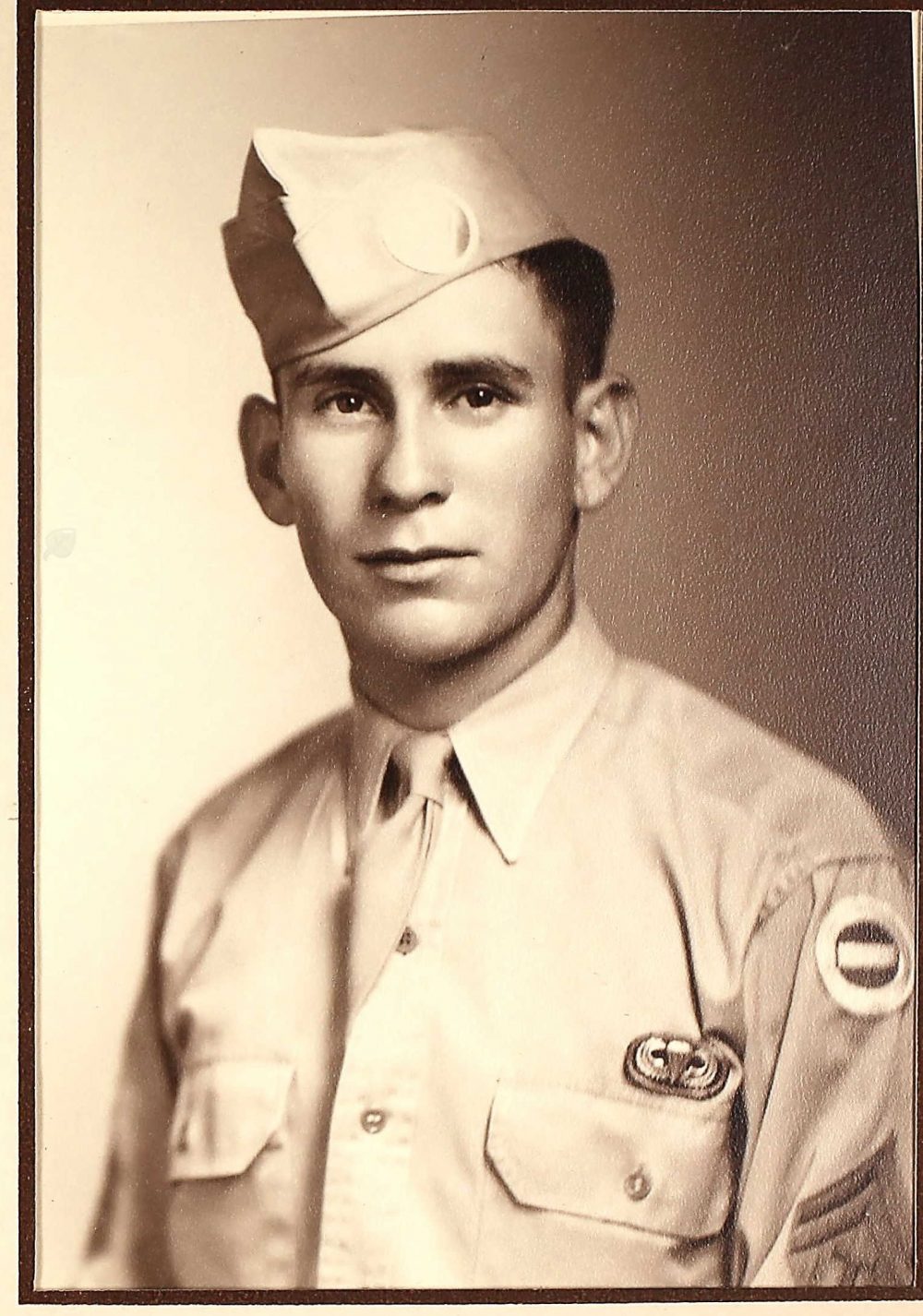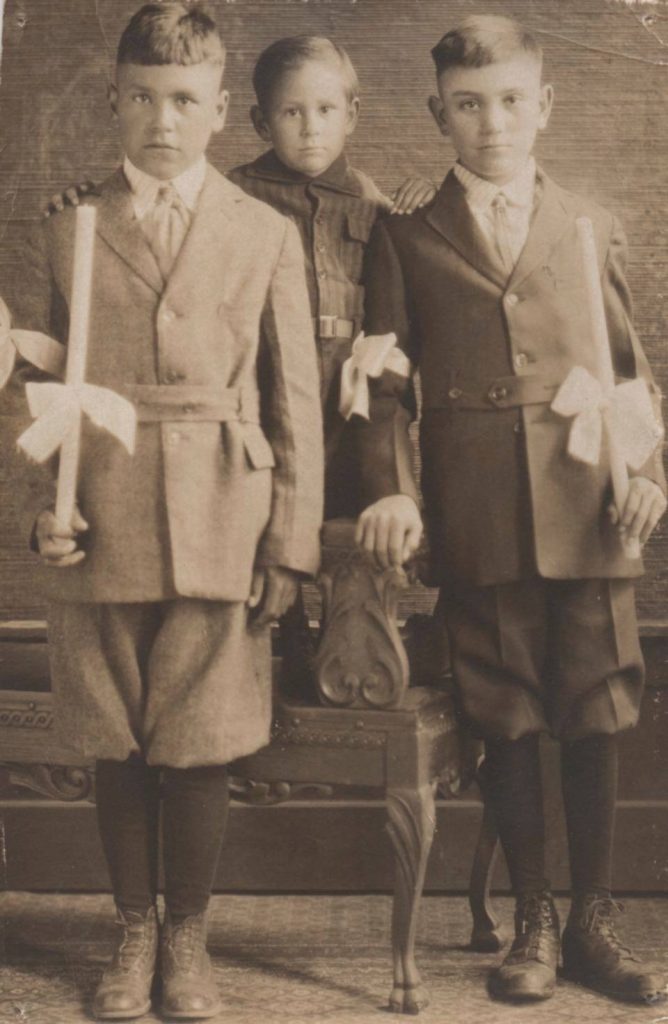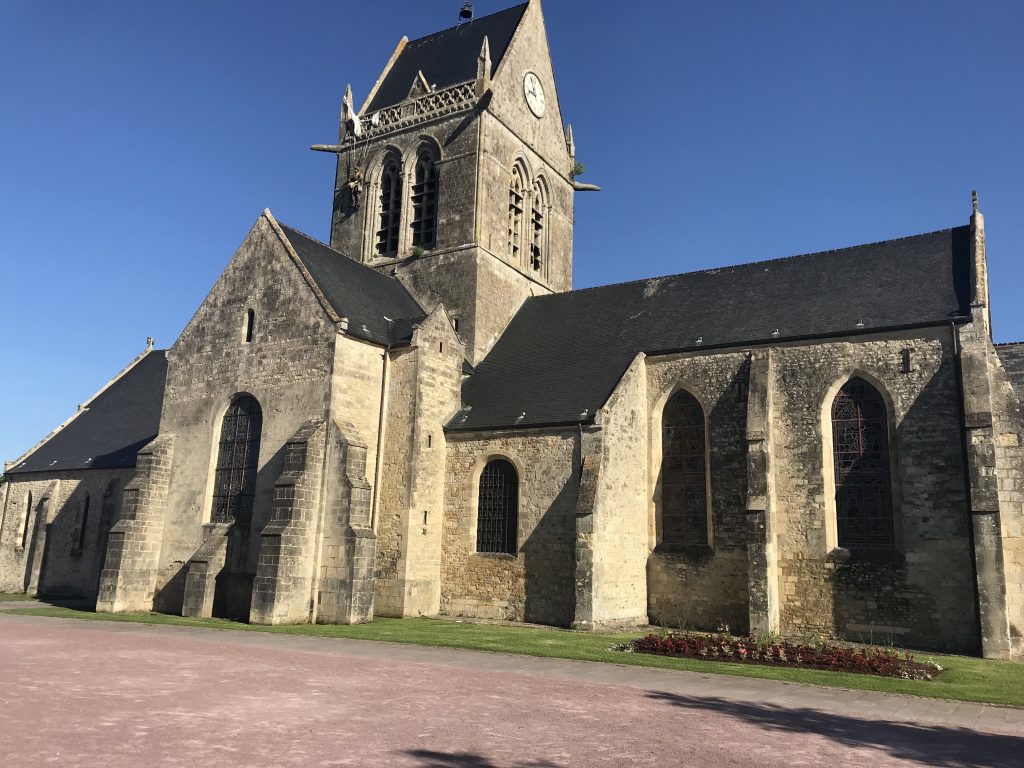Private Manuel Eloy Kemm

- Unit: 82nd Airborne Division, 507th Parachute Infantry Regiment
- Service Number: 18120255
- Date of Birth: July 11, 1921
- Entered the Military: May 12, 1942
- Date of Death: June 6, 1944
- Hometown: Las Vegas, New Mexico
- Place of Death: near Blosville, France
- Award(s): Purple Heart
- Cemetery: Plot C, Row 18, Grave 15. Normandy American Cemetery, Colleville-sur-Mer, France
Mentored by Mrs. Amy Page
Moriarty High School
2017-2018
Early Life
Manuel Eloy Kemm, began his life journey on July 11, 1921, in northern New Mexico. His parents, Juan Manuel Kemm and Maria Otilia Casias Kemm, and his godparents, Gregorio Sandoval and Ava Montoya, baptized him at Immaculate Conception Catholic Church in Las Vegas, New Mexico on December 2, 1921.
His father worked as a farmer to support a wife, mother, and two children at their home near Lucero, New Mexico in 1920. The family had long standing roots in the community and newspaper accounts list his mother as a member of the Mora County Land Grant established in 1835.
The family relocated to Las Vegas, New Mexico by 1930. Manuel Kemm and his brother Robert (Braulio) lived with their parents in a home near the railroad tracks rented for $15 a month. His father worked as a police officer and his mother was a midwife. The two brothers were very close to their ‘double’ cousin Gilbert- the boys mothers were sisters and their fathers were brothers. The boys attended and graduated from the Immaculate Conception School. Manuel attended one semester at the New Mexico Highlands University where he completed two classes.
The family purchased a home on the same street by 1940. Manuel, known as Skippy, was one of three children who survived to puberty. 18 other siblings died as infants, toddlers, or young children. His sister Eleana, died of meningitis as a teenager.

Homefront
The greatest New Mexican contributions to the war effort relied on culture and geography. Nearly 50,000 New Mexicans would serve in the war and find work at dozens of newly built military bases and facilities across the state.
Journalist Ernie Pyle and cartoonist and Bill Mauldin, both residents of New Mexico, played a critical role. Their work captured the GI experience and connected front lines to the readers at home.
New Mexico played a critical role during World War II. At Kirtland Air Force base a testing facility was built that tested proximity fuses, which were critical to anti-aircraft fire and the success of the Battle of the Bulge.
The Pajarito Plateau became the perfect location for the top-secret city of Los Alamos, New Mexico in 1943. The Los Alamos laboratories were home to Project Y of Robert Oppenheimer’s Manhattan Project where top physicists developed the atomic bomb. On July 16, 1945, the first bomb, “The Gadget,” was tested at the Trinity Site in near Alamogordo, New Mexico. The technology developed at Los Alamos was applied to the bombs dropped on Hiroshima on August 6 and Nagasaki on August 9, 1945.
The military determined the complex language of the remote Diné (Navajo) people, First Peoples to New Mexico, could be used in top-secret tactical codes. The U.S. Marine Corps recruited 29 Navajo Code talkers who were able to provide communication support. They created an unbreakable code that derived from Navajo words that were further scrambled by word association for radio transmission. Over 400 Navajo men ultimately served as Code Talkers and provided critical tactical communication during the war in the Pacific.
New Mexico also housed large numbers of German and Italian prisoners, and over 4,500 Japanese were interned in camps located in the state between 1942 and 1945.
Military Experience
Private Kemm was only 5 feet 6 inches tall and weighed 135 pounds when he traveled to Santa Fe, New Mexico to register for the draft on February 21, 1942. He was drafted into the military on May 11, 1942.
He completed basic training at Camp Wolters, Texas. He volunteered for the newly formed 507th Parachute Infantry Regiment and attended jump school at Fort Benning, Georgia in 1942. The trainees jumped off of 250 foot towers to practice descents. They learned to collapse parachutes in adverse weather conditions and repacked them on long tables in the packing shed. They participated in grueling ground operations and eventually jumped out of airplanes. Five successful jumps were required to earn the title paratrooper. The Las Vegas Optic quoted one of Private Kemm’s letters home in which he stated he, “thoroughly enjoyed this branch of the service and especially enjoyed making the parachute jumps.”
Soon after, the Regiment was attached to the 1st Airborne Brigade in Alliance, Nebraska. They joined the Glider Infantry and Carrier Regiments and conducted intensive joint operations from C-47 airplanes. The men also found time for fun at Fort Alliance. They formed competitive basketball and football teams. They managed to find dates while on weekend passes to Denver, and girlfriends and wives visited. Private Kemm was rumored to have a sweetheart from New Mexico named Betty. Private Kemm returned home for a visit in May 1943.
That December, the 507th Parachute Infantry passed through Camp Shanks, New York where they boarded the British transport ship, the SS Strathnaver, to Liverpool. Overcrowding, bad food, lack of ventilation, and widespread seasickness made the journey miserable. The American Liberty ship, USS Susan B. Anthony finally delivered them to Portrush in Northern Ireland for three months of field exercises.
Private Kemm’s 507th Parachute Infantry Regiment, including Company Headquarters, 2nd Battalion was attached to the 82nd Airborne Division in Nottingham, England, where they prepared for the Allied invasion. The Paratroopers were tasked with landing in Drop Zone T, northwest of Sainte-Mère-Église, and securing the Merderet River crossings. This was a critical mission, because the Allied forces needed to secure the roadways to hold back German Panzer divisions and forces during the beach landings and to ensure control of access points necessary for moving Allied troops and equipment inland.
At 11:50 p.m. on June 5, 1944, paratroopers loaded down with over 70 pounds of equipment, boarded C-47s bound for the Cotentin Peninsula. Private Kemm boarded a plane marked with tail number 25693 piloted by Second Lieutenant Russell G. Piper.
Poor visibility made it difficult for pilots to locate drop zones and scattered the air train. Paratroopers encountered heavy cloud cover and a barrage of bullets the moment they left the plane. The paratroopers of the 507th Parachute Infantry Regiment made their jump at 2:32 a.m. on June 6 in the Amfreville area. This unit had the worst mis-drop in the operation spanning across a 200-mile area. Many died in the air, drowned in marshes and flooded fields, or were injured or killed on landing. Survivors formed in small groups amidst the chaos.
At some point after leaving the plane and before the sun rose the next day, Private Kemm was killed in action. He was buried on June 7 in the Blosville Temporary Cemetery near Carentan, France. In 1948, Private Kemm’s remains were relocated to the Normandy American Cemetery at Colleville-sur-Mer, France.
The surviving members of the 507th Parachute Infantry Regiment fought valiantly. Paratroopers created formations to take on the German forces stationed in pill boxes, bunkers, behind hedgerows, and in Panzer tanks. Colonel Edson Raff took command of the 507th Parachute Infantry Regiment on June 15. They earned the name “Raff’s Ruffians” and participated in the Battle of the Bulge and Operation Varsity.


Eulogy
Private Manuel Eloy Kemm, son of Juan Manuel and Maria Otilia Kemm. His friends called him “Skippy.” He grew up in Las Vegas, New Mexico, a farming community where people are dependable and take care of each other, much like the towns he was sent to liberate in Normandy. This gave him the foundation needed to be a strong and reliable soldier.
The Kemm Family had already lost 15 children during infancy and childhood illness. It must have been difficult for his parents when Private Kemm was drafted to fight a war on the other side of the globe. Their sacrifice was both noble and selfless.
In the predawn hours of June 6, 1944, Private Kemm and 15 fellow paratroopers boarded a C-47 bound for France. The paratroopers experienced poor visibility due to foggy conditions and could hear enemy fire coming from all directions. Upon the commands “Stand up. Hookup. Check Equipment,” Private Kemm jumped into the darkness lit only by tracers aiming at the air from all directions. He was killed in action that day, just five weeks short of his 23rd birthday. The cause of his death is unknown but it is clear that he showed valor in the face of the enemy, taking the ultimate leap of faith.
Private Kemm, was raised a devout Catholic and carried two crucifixes and bible in his pockets. I am humbled to be able to honor my Silent Hero this and to lay a crucifix blessed in his home archdiocese on this sacred ground today as a memento of his sacrifice.
Reflection
My journey with the Normandy: Sacrifice for Freedom® Albert H. Small Student and Teacher Institute has been powerful and eye opening. The academic process provided me with a well-rounded understanding of World War II and the sacrifices made by people all over the world. The other student teacher teams inspired me to grow and learn all I could from the experience.
Walking in the footsteps of the soldiers and sailors allowed me visualize what the Allied Forces were trying to achieve. I could not believe the obstacles the Rangers faced upon landing at Pointe du Hoc. The tall, jagged cliffs would be hard to scale under the best of conditions. Looking through the slits of a German pillbox, the very spot from where the rounds that killed so many were fired, made me appreciate their bravery and determination.
We arrived at to Omaha Beach at low tide and the distance between the water line and causeways was so great. The sand felt hard like concrete and there was no place to take cover. It must have been terrifying to face the German forces firing in every direction from their positions the hills above the beach. The length of the beach was also shocking. It is so much bigger than anything I had imagined. It really solidified my understanding of the scale of the operations.
Visiting Sainte-Mère-Église was particularly impactful because it is the area where many of the paratroopers landed. It was surreal to stand in a peaceful French Village while imaging the destruction that preceded. It also made me realize how disorienting it would have been to miss a drop zone and have to fight one’s way to the nearest Americans.
I was struck by the beauty and care given to the Normandy American Cemetery. When I heard the bells play the national anthem, I was overcome by emotion. At that moment, I went from understanding to feeling their sacrifice. My tears made it hard to read my Silent Hero’s eulogy. Wiping the sand from the letters on his grave marker, and then placing his image, a rose, and a crucifix at its base made was humbling and peaceful. I am proud I was able to honor the fallen and understand that we have a duty to protect the very same freedoms they died for.
Bibliography
Primary Sources
82nd Airborne Division; Office of the Division Commander; National Archives at College Park, College Park, MD.
82nd Airborne Division; Records of the Adjutant General’s Office, World War II Combat Operations Report 1940-1948, Record Group 407 (Box 10395); National Archives at College Park, College Park, MD.
“400 Arrive at Santa Fe Camp. The Newell Star, Vol. II, No. 26. June 4, 1945. Densho (ddr-densho-284-74). ddr.densho.org/ddr-densho-284-74/.
507th Parachute Infantry Regiment. The 507th Parachute Infantry Regiment (PIR) Yearbook. Denver: Bradford-Robinson Print. Co., 1943.
507th Parachute Infantry Regiment; Records of the Adjutant General’s Office, World War II Combat Operations Report 1940-1948, Record Group 407 (Box 6605); National Archives at College Park, College Park, MD.
Associated Press. Gen. Leslie Groves (r) and Dr. J.R. Oppenheimer examine the remains of the tower from which a test atomic bomb was detonated near Alamogordo, N.M. Photograph. 1945. New York World-Telegram and the Sun Newspaper Photograph Collection, Library of Congress (LC-USZ62-128768). Image.
Bureau of Indian Affairs. First 29 Navajo U.S. Marine Corps Code-Talker Recruits being Sworn in at Fort Wingate, NM. Photograph. 1942National Archives and Records Administration (295175). Image. www.docsteach.org/documents/document/first-29-navajo-us-marine-corps-codetalker-recruits-being-sworn-in-at-fort-wingate-nm.
Department of the Navy. Atomic Bomb Memo. September 11, 1945. National Archives and Records Administration (7321534). Image. catalog.archives.gov/id/7321534.
Enrollment Records, 1940-1945. Registrar’s Office Collection, New Mexico Highlands University. 1940. University Archives, Thomas C. Donnelly Library (Box 5, Folder 6).
Kemm Family Photographs. 1920s. Courtesy of Pat Kemm Mann.
Manuel Eloy Kemm Baptismal Certificate, December 2, 1921. Immaculate Conception Catholic Church, Las Vegas, New Mexico.
Manuel E. Kemm, Individual Deceased Personnel File, Department of the Army.
Manuel E. Kemm. World War II Draft Registration Card. Digital Image. fold3.com.
Memorandum from Commander General Clayton B. Vogel to the Commandant, U.S. Marine Corps, Regarding Enlistment of Navaho Indians. March 6, 1942. National Archives and Records Administration (Record Group 127). www.docsteach.org/documents/document/memorandum-from-commander-general-clayton-b-vogel-to-the-commandant-us-marine-corps-regarding-enlistment-of-navaho-indians.
New Mexico. Mora County. 1920 U.S. Census. Digital Images. ancestry.com.
New Mexico. San Miguel County. 1930 U.S. Census. Digital Images. ancestry.com.
New Mexico. San Miguel County. 1940 U.S. Census. Digital Images. ancestry.com.
Office of War information. U.S. Paratrooper Checks Invasion Equipment. Photograph. June 1944. National Archives and Records Administration. Image.
Records for Manuel Kemm; World War II Honor List of Dead and Missing Army and Army Air Forces Personnel from New Mexico, 1946. Record Group 407; National Archives at College Park, College Park, MD.
Roosevelt, Franklin D. Letter to J. Robert Oppenheimer, J. Robert Oppenheimer Papers, Library of Congress (A70). www.loc.gov/item/today-in-history/december-02/.
Truman, Harry S. Statement of the President of the United States. August 6, 1945. Ayers Papers, Harry S. Truman Presidential Library. trumanlibrary.org/whistlestop/study_collections/bomb/large/documents/index.php?documentdate=1945-08-06&documentid=59&pagenumber=1.
U.S. Army Air Forces. Nagasaki, Japan under atomic bomb attack. Photograph. August 9, 1945. Library of Congress (2002722137). www.loc.gov/resource/ds.05458/.
Secondary Sources
Cuthbertson, Heather. “Herman Saiz.” University of Texas Libraries. Last modified November 3, 2002. Accessed February 3, 2018. legacy.lib.utexas.edu/voces/template-stories-indiv.html?work_urn=urn%3Autlol%3Awwlatin.409&work_title=Saiz%2C+Herman.
“D-Day: The Secret Massacre.” Investigating History. The History Channel.
Druckenmiller, David, and Phil Walker, prod. D-Day: Down to Earth — Return of the 507th. PBS Home Video, 2002. DVD.
“Ernie Pyle.” Indiana University Media School. Last modified 2018. Accessed May 17, 2018. mediaschool.indiana.edu/erniepyle/.
Kelly, Cynthia C. Manhattan Project: The Birth of the Atomic Bomb in the Words of Its Creators, Eyewitnesses, and Historians. New York: Black Dog and Leventhal Publishers, 2007.
Knowles, Jane. “Hacienda de los Torres.” Office of the State Historian. Last modified July 1999. Accessed March 1, 2018. newmexicohistory.org/places/hacienda-de-los-torres-1.
Miller, Michael. “Lo de Mora A History of the Mora Land Grant on the Eve of Transition.” Office of the State Historian. Accessed March 2, 2018. dev.newmexicohistory.org/filedetails.php?fileID=21925.
Morgan, Martin K.A. Down to Earth: The 507th Parachute Infantry Regiment in Normandy: June 6-July 11 1944. Atglen: Schiffer Publishing, 2004.
“Navajo Code Talkers and the Unbreakable Code.” Central Intelligence Agency. Last modified November 6, 2008. Accessed March 5, 2018. www.cia.gov/news-information/featured-story-archive/2008-featured-story-archive/navajo-code-talkers/.
Rand McNally Standard Map of New Mexico. Chicago: Rand McNally and Company, 1924.
Siddall, Brian. 507th in Normandy: The Complete Jump and Aircrews for Operation Neptune. Ithaca: EQS Press, 2007.
Siddall, Brian. Boots and Wings: The 507th Parachute Infantry Regiment’s Regimental Newspaper. Ithaca: EQS Press, 2007.
Stamatov, Suzanne. “Code Talkers.” Office of the State Historian. Accessed March 2, 2018.newmexicohistory.org/people/code-talkers.

